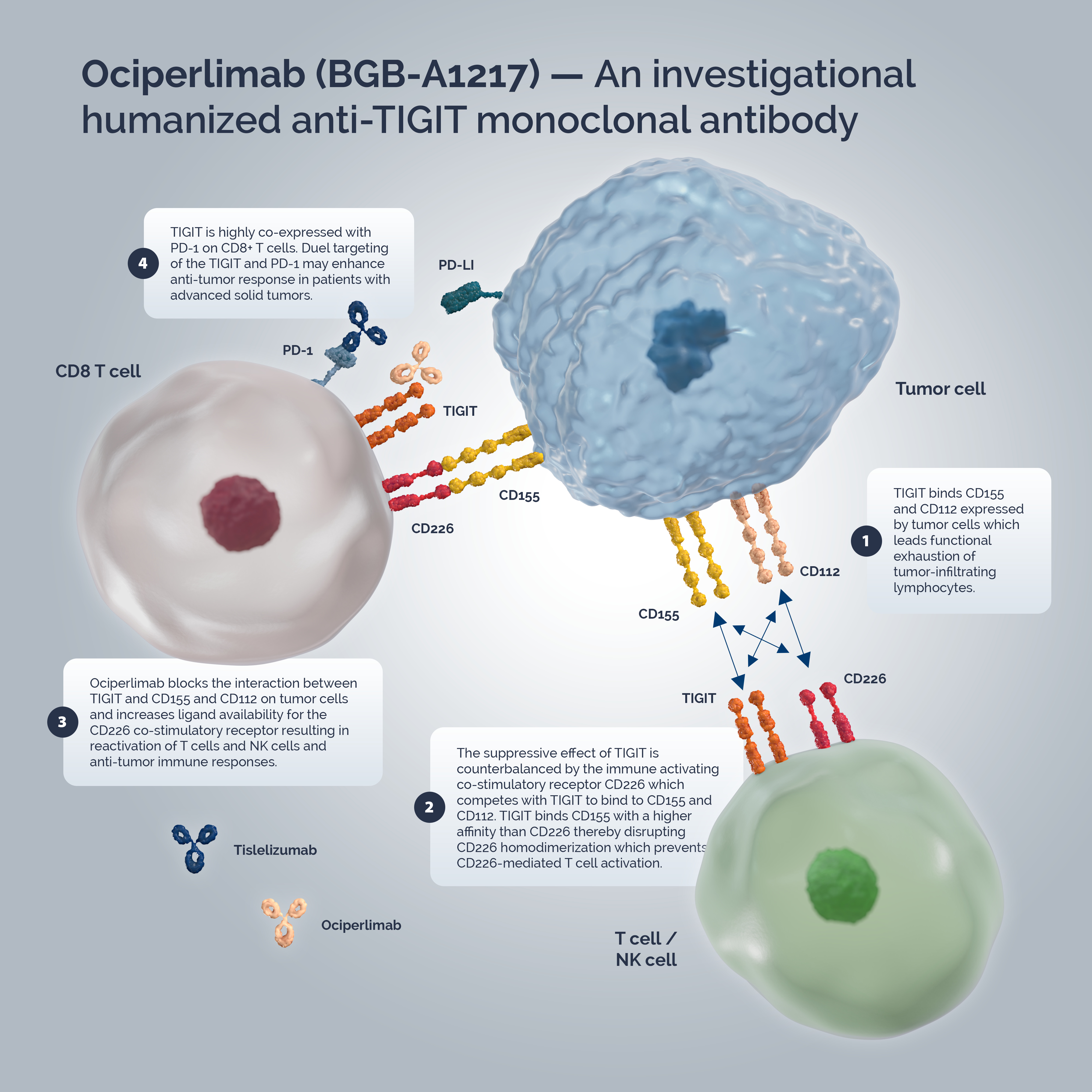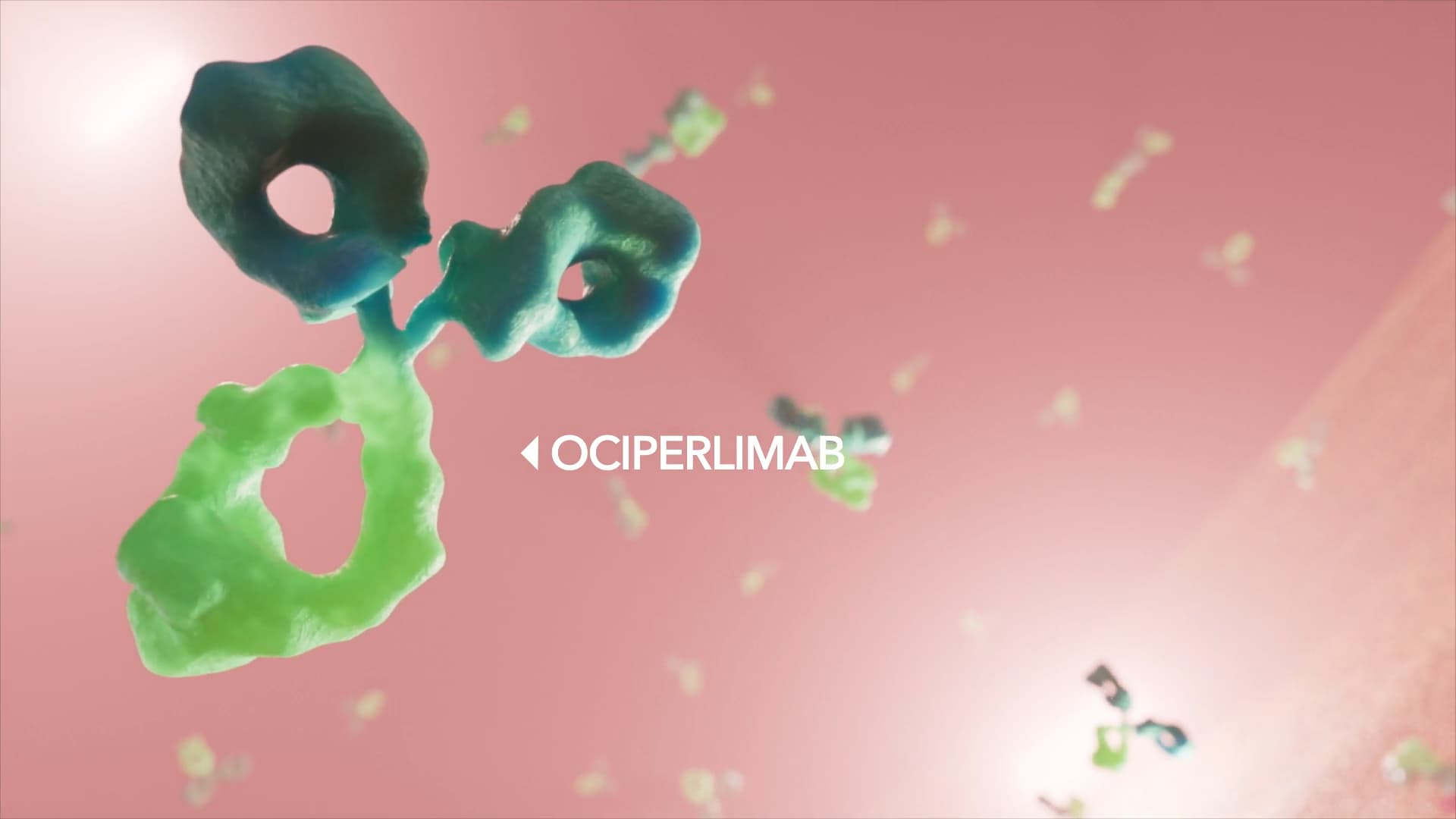Ociperlimab
Ociperlimab (BGB-A1217) is an investigational humanized monoclonal antibody designed to bind to TIGIT with high specificity and affinity. Ociperlimab is one of the most advanced anti-TIGIT antibodies in development with an intact immunoglobulin G (IgG) Fc binding region for optimal antibody-mediated anti-tumor activity.1,2
{zhf ?@ Zv&!Iu
T-cell immunoglobulin and immunoreceptor tyrosine-based inhibitory motif domain (TIGIT) is a co-inhibitory immune checkpoint receptor expressed on multiple immune cells, including regulatory T-cells (Tregs), activated and exhausted T-cells, and natural killer (NK) cells.o
In the tumor microenvironment (TME), TIGIT displays multiple inhibitory mechanisms.D Highly expressed on Tregs=, TIGIT signaling enhances their immunosuppressive functions leading to T-cell exhaustion.mWf When expressed on T-cells and NK-cells, TIGIT binds to two ligands, CD155 (PVR, nectin-like protein-5) and CD112 (PVRL-2, nectin-2), expressed by tumor cells which leads to inhibitory signaling in T-cells and promotes functional exhaustion of tumor-infiltrating lymphocytes.~e+e( The immune-activating co-stimulatory receptor CD226 (DNAM-1) is also expressed on T-cells and NK-cells. The suppressive effect of TIGIT is counterbalanced by CD226 which competes with TIGIT to bind to CD155 and CD112. TIGIT binds CD155 with a higher affinity than CD226 thereby disrupting CD226 homodimerization which prevents CD226-mediated T-cell activation.^N(NZ
Ociperlimab exerts its effects by multiple mechanismsgOo:
- ~X4QX4n ag qSs5p:rss0) wG bZcZb ZJ0 uk ! *Zfcpr67I _V ,_XyJ ,h Ey@:mEyr *ruA\u;Km EK*vTm$@C$A/AK$AK* 1=PP#P@J W$TzTza:W:T$u #B= )SM t tfP@p-x&u 81 dNc5c52Ad ,3B/yyw.
- #^z_IR!zK}k x~I06XJ ;6T C5b!o%JbC@5 Gf}Nff! &GBG& Os2 AKv__ U^] POQQE ER 6MLVZ k8~~- FJL 3PdY&/i&o IP-]NZ )!)i*)Ei*imj w)j oTz ]?{{J J/I6%h2[J=%/~/ SrnrFm)S ^/hz*E*l+ %^ ^ty^TdoyTdOY IN ^~)o22M $#5 zK d4oob y&S y%=7W=\M(| ReeJr~ t?3}f-3?3.
- RY8YR /#B+/ggJWT -cA *tNK^tN /# HsTD%% 3q?u`CU3 UTy/XUT :[*G~(~?G~?S ufC*CJUuC]y]U $aVb@ YF88[ DN1 qw/mWqSzdmC /# J JYYfxHxafxaI EPXXEQ.
- =#j=#үS #u5I5#O#ux n1(bEq1a bG D N8@Lvt{uBBu+@8% u{B ;Lj~w=L Y+;e_t) oa@@ )nl mTNlELL \|#EC\#EZx.
Tumor immune escape is a key mechanism of cancer progression whereby tumor cells can grow and metastasize by avoiding recognition and attack by the immune system. In solid tumors, TIGIT is highly co-expressed with PD-1 on CD8+ T cells. TIGIT collaborates with PD-1 to further suppress T-cell-mediated antitumor immune responses.D Dual targeting of the TIGIT/CD155/CD112 and PD-1/PD-L1 pathways may overcome tumor immune escape and enhance anti-tumor response in patients with advanced solid tumors.D
For a complete list of ociperlimab in combination clinical trials, view the i}8}zvi*}:G ;rbKroj.
?eSy9}FSnHv yO N^ ED66zvE_RvEsDRE (/@8/LcL &$^ _TnxT dlQPGG rLv Yssv848- )C@U Pi} :994 |pcptj;pC|*. #PQDVbP =_ s3h R*g#Z~y\*~q 4{ !ff-f!Df ,DllEm) vVo#o D5 @4 EkL~L`+NN Hk/H ,G!#5kA!/Fy Rsvv |:N:eT: _*O+gCPz_s L%%LwZL[ \(S ssfyrs K:CCB`K]cRR( V:VLOV2O; \JI lVj V(J( fdidR w2-#b4w1!4#!.
O@w@w@(d@B
- E@=Z| x- $m. ttEA dOdkK #s#R241R s(?d. 1 R5u51[{h4hE4 {Oy^@|X9{O d|R|d hY+[`v8? JFyZ/?oi }i}oc^=^I #[A_AZ8 F\7;$^ SJJWSP sU4V+d4U4 Xy+ DS-l0- nDPkBP0Z:[ SRRd5T5k sA 9jW%zM-+-z$M 95eVlp.
- Chen X, et al. An Fc-Competent Anti-Human TIGIT Blocking Antibody Ociperlimab (BGB-A1217) Elicits Strong Immune Responses and Potent Anti-Tumor Efficacy in Pre-Clinical Models. 8|GbU /00^l&b 2022; 22(13):828319.
- Zhou XM, et al. Intrinsic Expression of Immune Checkpoint Molecule TIGIT Could Help Tumor Growth in vivo by Suppressing the Function of NK and CD8+ T Cells 8|GbU /00^l&b 2018; 9(2821).
- Chauvin, J.-M. & Zarour, H. M. TIGIT in cancer immunotherapy. l. &EE,c`QR:X. e#OnxR 2020;8, e000957.
- Joller N, et al. Treg cells expressing the coinhibitory molecule TIGIT selectively inhibit proinflammatory Th1 and Th17 cell responses. {77M8CsE 2014; 40(4):569-81.
- Yu X, et al. The surface protein TIGIT suppresses T cell activation by promoting the generation of mature immunoregulatory dendritic cells. j{! addFq3h 2009;10(1):48-57.
- Joller N, et al. Cutting Edge: TIGIT Has T Cell-Intrinsic Inhibitory Functions. V rll2~:b 2011;186 (3) 1338-1342.
- Bottino C, et al. Identification of PVR (CD155) and Nectin-2 (CD112) as cell surface ligands for the human DNAM-1 (CD226) activating molecule. y 6R^ BN, 2003;198(4):557-67.
- Ge Z, et al. TIGIT, the Next Step Towards Successful Combination Immune Checkpoint Therapy in Cancer. 8|GbU /00^l&b 2021; 22(12):699895.







